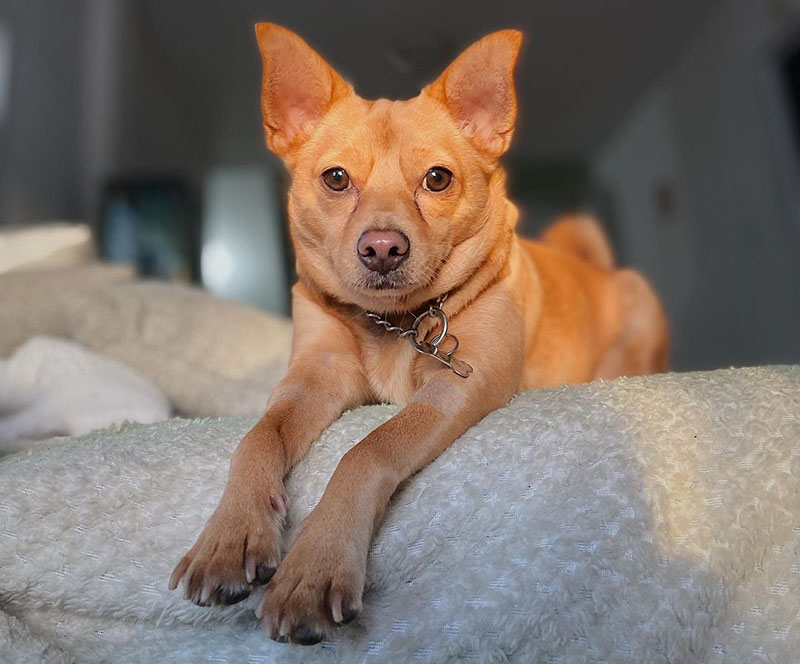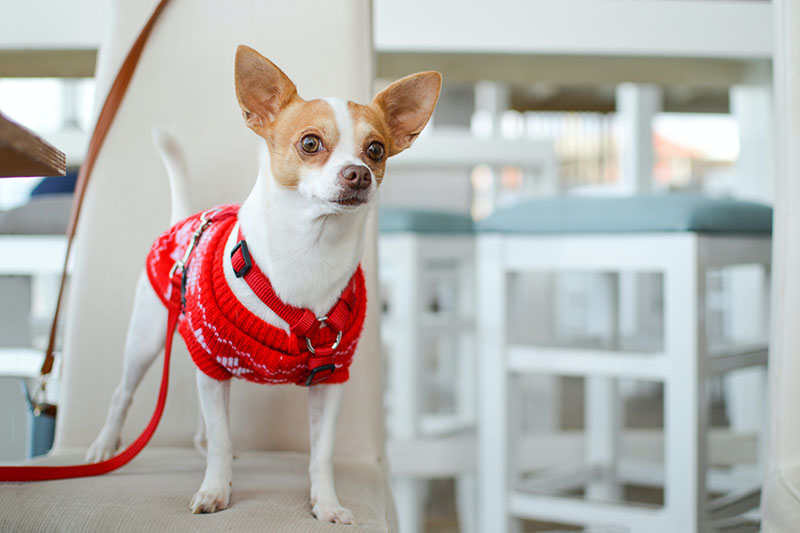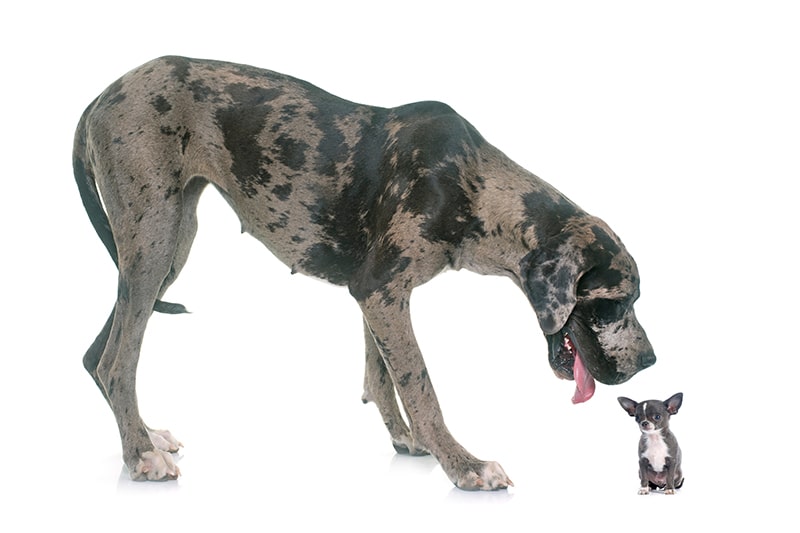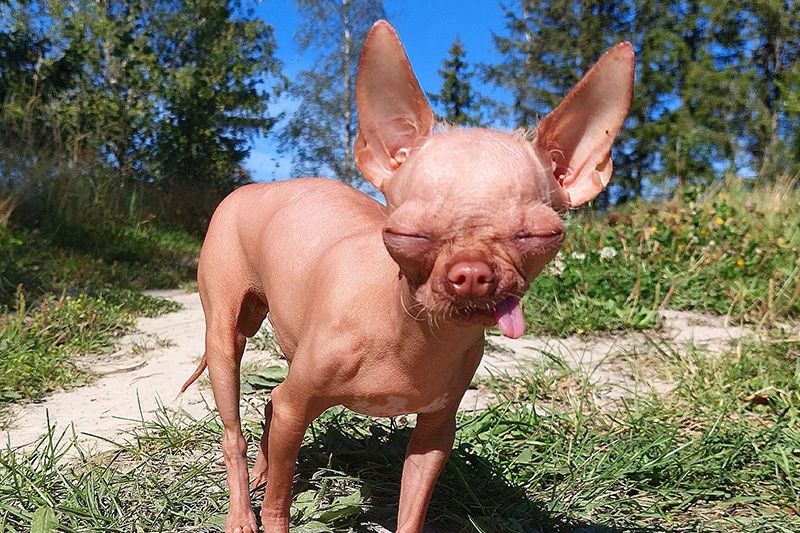The Chihuahua Basenji mix is an active, small, mixed-breed created by combining the Chihuahua and the African Basenji. Although highly rare, this mixed-breed pup is slowly gaining popularity in the United States, as people search for an active, enduring pup that knows how to have fun, and can serve (perhaps accidentally) as a guard dog.

The Basenji breed is renowned for being a low-bark or barkless breed – meaning that you might not encounter excessive barking that you’re used to with a traditional Chihuahua mix. Otherwise, your Basenji Chihuahua will inherit large parts of it’s personality and temperament from each parent breed.
Chihuahua Basenji Mix – At a Glance
| Weight: | 10 – 15 pounds |
| Height: | 9 – 14 inches |
| Lifespan: | 12 – 15 years |
| Coat Colors: | Combination of tan, brown, cream, white |
| Temperament: | Independent, active, bouncy, affectionate, reserved |
| Most Suitable For: | Active families, active single individuals, unsuitable for the elderly or apartment dwellers |
What Does a Chihuahua Basenji Mix Look Like?

The Basenji Chihuahua mix will inherit different parts of it’s physical appearance from each parent breed. As with most mixed-breed dogs, it can be difficult to give an accurate prediction of their physical appearances, as it largely depends on the predominant genes.
Your Basenji Chihuahua mix will likely inherit the larger head of the Basenji along with the elongated body shape of the Basenji and upright, triangular ears. You can expect it to be lean with short legs, like the Chihuahua, with a longer snout than a Chi.
In terms of coat colors, it’s likely to be tan or brown, combined with white markings. It will have a single coat, making it not ideal for colder climates. It’s also likely to have rounded eyes, like the Basenji.
Are you looking for a way to treat your furry friend? Sign up for our newsletter for a chance to win a free month of Barkbox!
The History of the Chihuahua Basenji Mix
Unfortunately, as one of the rarer Chihuahua mixes, the Chihuahua Basenji doesn’t have an extensive history.
Luckily, both parent breeds – the Chihuahua and Basenji have extensive histories to glean from. These two similar-sized breeds from different parts of the world, but combine for an athletic and active mixed-breed dog.
The History of the Basenji

The Basenji is an athletic and active breed from Central Africa. The Basenji is what is known as a “basal breed” – a breed that predates modern breeds of the 19th century. The Basenji was first described in 1895 by Europeans in the Sudan as local dogs, although the genetics of the Basenji stretch back to the wolf and they are genetically related to the Siberian Husky, along with the Dingo.
The Basenji began to be exported to the United States and Europe in the 1930s, when the breed was stabilized following an original import attempt into Europe in 1923 – when all six imported Basenjis died of distemper.
The Basenji was recognized by the American Kennel Club in 1943, although numbers have dropped significantly in the United States, but they were reinvigorated in 2010, following expeditions from breeders in the US to collect breeding stock from the Congo.
How Popular Are Basenjis in the United States?
Despite being relatively rare in the United States, Basenjis are quite popular – coming regularly within the top 100 most-popular dogs in the United States, as measured by the American Kennel Club.
In 2021, Basenjis were the 87th most-popular dog in the United States.
Who Are Basenjis a Good Dog For?
Because of their high activity levels and athleticism, Basenjis are best-suited for the active single person, or the active family unit.
How Did Basenjis Come About?
The precise history of the Basenji is difficult to ascertain, although they are known as a basal breed, as they pre-date the modern era of dog breeding, which began in the 19th century. They are thought to herald from wolves, huskies and Dingoes.
When Did We First Cross-Breed The Basenji?
The Basenji has become a popular crossbreed in Europe and the United States, particularly following their initial importation during the 1930s.
Since then, the Basenji hasn’t quite been caught up in the crossbreeding craze of the 1990s and early 2000s. However, there are still a few popular Basenji crosses out there. These include:
- Basenji Beagle Mix (Baseagle)
- Basenji Great Dane Mix (Great Dasenji)
- Basenji Welsh Corgi Mix (Corsengi)
- Basenji Labrador Retriever Mix (Labrasenji)
- German Shepherd Basenji Mix (German Shepenji)
The History of the Chihuahua

The Chihuahua is a small, active and feisty pup with an ancient lineage stretching back to the 9th century, when the Aztec tribe – the Toltec Peoples – kept a small, mute dog known as the Techichi as a companion pet. These small, mute breeds were revered by the Aztecs – their likeness was discovered on hieroglyphs in the Mexican state of Chihuahua, centuries later.
In modern times, the Chihuahua was first noted in Mexico in the mid-19th century and were routinely traded with American tourists visiting border towns in Mexico. By the late-19th and early 20th centuries, the Chihuahua had become popular enough in the United States for it to be recognized by the American Kennel Club in 1904.
How Popular Are Chihuahuas in the United States?
Since their recognition by the American Kennel Club, the Chihuahua has fast become one of the most popular toy dog breeds in the United States.
In 2021, they ranked as the 37th most-popular dog in the United States, according to the American Kennel Club.
Who Are Chihuahuas a Good Dog For?
Chihuahuas are mostly thought of as being great pets for the elderly due to their size and generally gentle demeanor. While this is mostly true, any elderly person living in an apartment may struggle to own a Chihuahua, due to their excessive barking.
Chihuahuas are fiercely loyal to their owners and may protect them aggressively, while this can certainly be mitigated with obedience training and socialization, it’s worth noting if you have younger children, or are frequently visited by people.
In general, Chihuahuas are wonderful family dogs and great companion pets for the elderly relative.
How Did Chihuahuas Come About?
Chihuahuas were first noted in the mid-19th century in the Mexican state of the same name, but are ancestrally linked to the Techichi – a small, mute dog kept by the Toltec Peoples – an Aztec tribe that inhabited Mexico in the 9th century.
Following the increase in tourism in Mexican border states in the late-19th century, the Chihuahua was traded and sold to American tourists, who kept them as companion pets. They were first recognized by the American Kennel Club in 1904.
When Did We First Cross-Breed The Chihuahua?
The first instance of crossbreeding of the Chihuahua in modern times occurred in the United Kingdom at the end of the Second World War. While the English were desperate to maintain the popularity of the Jack Russell Terrier, which had fallen out of favor, they decided to crossbreed it with various breeds, including the Chihuahua.
In the United States, crossbreeding of the Chihuahua became more popular in the 1990s and early 2000s. Several popular Chihuahua crosses that were developed during this time include:
- Chihuahua French Bulldog Mix (French Bullhuahua)
- Chihuahua Cairn Terrier Mix (Toxirn)
- Chihuahua Yorkie Mix (Chorkie)
- Chihuahua Maltese Mix (Malchi)
- Chihuahua Labrador Retriever Mix (Lab Chi)
How Important Is a Dog’s Temperament to Your Family?
One of the most important elements of getting ready to welcome a new dog into your family is the process of familiarizing yourself with the potential temperament of that pup. Dog’s temperaments come from two sources: their genetics and lived experience.
To ensure that your new dog matches with your family’s desired pet, you’ll need to ask yourself what you’re looking for from prospective family pet. Are you hoping for an athletic, active companion? Or are you looking for a more laid-back, laissez-faire pet?
Certain dogs are also better around smaller children and other pets – if you have little kids, or other pets, particularly rodents, you’ll want to ensure that a strong prey drive isn’t present in your new dog’s temperament.
Conducting thorough research on your new pet will make the transition to owning a new dog that much easier for you, the dog and your family.
What is the Temperament of the Chihuahua Basenji Mix?
As with many mixed-breed dogs, you can expect your Chihuahua Basenji mix to inherit different parts of it’s temperament from each parent breed. It’s likely to be slightly standoffish around strangers, though not necessarily aggressive (more suspicious than aggressive).
The Chihuahua Basenji mix is also going to be a hugely active pup, so expect to be kept on your feet. Likewise, your Chihuahua Basenji mix is very intelligent, be sure to keep their brain busy!
Is The Chihuahua Basenji Mix Friendly?
In general, you can expect the Chihuahua Basenji mix to be very friendly and affectionate towards those it knows. However, it will also likely exhibit suspicion of those it doesn’t, as they get a protective streak from their Chihuahua genes.
Is The Chihuahua Basenji Mix Easy to Train?
You may experience some initial difficulty with training the Chihuahua Basenji mix. Chihuahuas are notoriously stubborn and Basenjis tend to be very independent, this could mean a lack of willingness to follow commands at first.
Use reward-based training, or positive reinforcement training to break through that initial layer of stubbornness and independence to keep your Basenji Chihuahua mixes attention.
How Much Can A Chihuahua Basenji Mix Weigh?
The average weight of the Chihuahua Basenji mix is between 10 and 15 pounds.
How Tall Can A Chihuahua Basenji Mix Get?
The average height of a Chihuahua Basenji mix is between 9 and 14 inches tall.
Similar-Sized Breeds
There are a few similar-sized breeds to the Chihuahua Basenji mix. These include:
- King Charles Spaniel
- Cairn Terrier
- Chinese Crested
- Lhasa Apso
- Pomeranian
Does the Chihuahua Basenji Mix Shed?
Your Chihuahua Basenji mix will likely be a low-shedding dog that requires minimal coat maintenance. A weekly brush with a light brush might be a good idea, but don’t expect to need regular trips to a professional groomer.
How Much Exercise Does A Chihuahua Basenji Mix Require?
When it comes to activity, expect your Chihuahua Basenji mix to be very active. They require at least 45 minutes of daily exercise, including mental stimulation – alongside physical activity that includes time off-leash.
How Long Can a Chihuahua Basenji Mix Live?
The average lifespan of a Chihuahua Basenji mix is between 12 and 15 years.
What Health Conditions Could the Chihuahua Basenji Mix Have?
- Tracheal Collapse (Respiratory Condition)
- Epilepsy (Neurological Condition)
- Hypoglycaemia (Canine Diabetes)
- Patellar Luxation (Kneecap Dislocation)
How Can You Find a Chihuahua Basenji Mix Puppy For Sale?
Before you start searching for a Chihuahua Basenji mix puppy for sale, consider finding one to adopt instead. Sometimes, animal shelters or vet clinics come across Chihuahua Basenji mixes that are put up for adoption by their owners. Not only will this save you time and money in purchasing costs, you can give an old dog a new home!
If you’ve had no luck with animal shelters or vet clinics, consider searching online at AdoptAPet.com, which allows you to search your local area for Chihuahua Basenji mix puppies for adoption.
How Much Does a Chihuahua Basenji Mix Puppy Cost?
The average cost of a Chihuahua Basenji mix is between $1000 and $1200! This is almost triple the cost of your average adoption!
If you’re willing to pay that price for a Chihuahua Basenji mix, definitely make sure you’re buying from a reputable breeder and not a puppy mill. We highly encourage you to read our article on distinguishing puppy mills from reputable breeders before engaging with a breeder.
Is the Chihuahua Basenji Mix the Right Breed For You?
If you’ve been searching for a spry cross to bring a bit of spice to your life, then the Chihuahua Basenji mix might be perfect for you! If you’ve been looking for a companion pet that’s upbeat, inquisitive but doesn’t require a lot of attention, the Basenji Chihuahua might be perfect!
However, if you’re convinced that the Basenji Chihuahua mix isn’t the right breed for you, then consider reading our other breed guides to learn about other mixed-breed dogs that might be more suitable.



